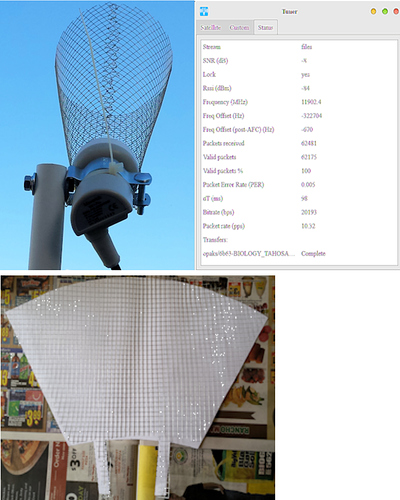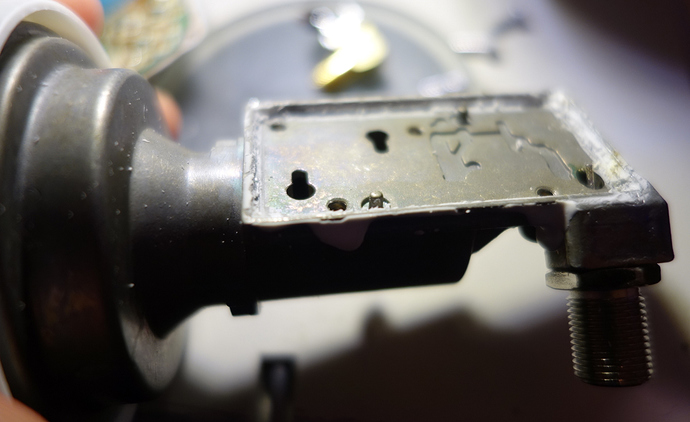I find that my best aid in aiming the LNBF, whether with a shield attached or not, is having a small laptop computer in hand, connected to skylark, and in the tuner screen. With this you can directly view the SNR. I try pointing with the Dreamcatcher in hand but usually can’t get enough fluctuation in the indicators to really get an accurate point. It works fine for the first acqusition and assures you that you are on the right sat. Then the computer with the tuner app quantifies the SNR so that small differences are easy to see.
I think it would be useful if the LCD would display the SNR in a bargraph.
–Konrad, WA4OSH
I think (that’s a maybe) that I ended pointing to the satellite 85 W AMC/GE 16. I slewed around for the signal strength using my little Freesat satellite finder and I think I get two or three advertiser channels for Dish or Direct and a cspan channel. Some appear to be Boston nbc 10 …
So … using the satellite finder/receiver is not the best for me… since it really doesn’t tell my if I am aligning with 87 W.
The only nice thing is the satellite finder is battery powered and provides either the V or H bias that the lnb needs. You still have to kinda guess at a transponder frequency and bandwidth to look for, and I know It won’t detect the lora modulated outernet signal.
@Konrad_Roeder
Are you using a standard photographer’s tripod? If so, the conduit hanger clamp I am using to hold the LNB ($0.76) plus a 1/4" x 20 nut will hold your LNB plus give you the ability to put “ears” on the bottom end of the shield to help fit it to the clamp. Just an idea…
@Syed
@zoltan
@Konrad_Roeder
@kenbarbi
We tried the second funnel inside the first in the previous experiment, however, did not gain anything with that effort.
Here are the status results and pictures from the 1/4 grid “hardware cloth” cone from today. The opening at the LNB is 2-1/2 inches, the opening toward the sky is 5 inches in diameter and the cone is 8 inches from LNB to the outer opening. I was quite surprised at the great SNR (8 to 9). This is very light, although the steel material is nasty to your fingers and not fun to work with. I made a rough pattern, cut it out, then bent edge spikes around each other to keep it together. My pattern was not very good, but the results still were good. This likely would not be great in the areas where it snows, however, that remains to be seen…
awesome! 
 how many dB improvement is this mean, what do you guess? I seen in your previous posts that the bare LNB SNR is -14.25…-13 dB so am I right that the improvement was ~5dB?
how many dB improvement is this mean, what do you guess? I seen in your previous posts that the bare LNB SNR is -14.25…-13 dB so am I right that the improvement was ~5dB?
Yes
That’s how I’m holding the LNB to my stand.
–Konrad, WA4OSH
I have been given several dishes that use these right-angle type LNB’s. I have yet to take off the shell off of a Maverick MK1-PLL to see if it fits inside of mine.
–Konrad, WA4OSH
This is proving that the “satellites experts” are not the best resource. In “theory” a 1/4" grid mesh would NOT be a great shield or reflector of a 11.9 GHz. In “theory” it would have to be almost a “solid” or at least thin coating … So we are setting new standards.
Maybe we are actually shielding RF signals at the lower 1GHz output product of the lnb or something in the downblock conversion. Looking at the typical Maverick lnbf it is mostly plastic and not a RF hardened enclosure.
My experiment is going to be… Is the “cone” really needed or do we just need to shield all sides (except the front) of lnb to improve the SNR.
update: I just pulled out of my box of toys, an Xtreme II lnbf
https://www.ebay.com/itm/Single-Standard-Xtreme-II-Liner-Ku-Band-FTA-Satellite-Dish-LNB-LNBF-0-3dB-HDTV/331802474277?ssPageName=STRK%3AMEBIDX%3AIT&_trksid=p2057872.m2749.l2649
It is in a cast metal housing. I will experiment today
@zoltan in my opinion that is a fair assumption, ~5dB. Of course, I have no scientific proof that I am spot on with my aiming at all times, either, as it seems to vary a bit day-by-day using the bare LNB. I have seen days where it was possible to do -12 with the bare LNB, but it seems that is a stretch, and also seems to be quite critical to keep the LNB pointed spot-on for this good an SNR. Thanks for the view of the undressed Maverick MK1.
“This is proving that the “satellites experts” are not the best resource. In “theory” a 1/4” grid mesh would NOT be a great shield or reflector of a 11.9 GHz. In “theory” it would have to be almost a “solid”…"
I think the “satellite experts” likely have to lean toward general situations of “what works for sure” and what can be easily mass-produced and installed by some field technicians (installation mechanics) who have little or no knowledge of wave propagation or antenna theory. And I agree also that with this type of experimentation, we may accidentally stumble right past a good solution due to our own ignorance of some of the laws of physics, or we may, in the same iteration, fall into an occasional win. My accumulated opinion thus far of all the things we have tried, perhaps this one is a “tad” better in some ways, but it is yet also an awkward device to build and work with. And true, this all still begs the question, do we really know for sure what it is that we are shielding from?
I wonder how well something like this would work?
I would assume that to cost about $10,000.
I’m not talking about the cost but mimicking the size of the antenna. Just to see the difference between a cone and a miniature dish. I’d love to try this out myself, but between work and the season itself, my time will be limited as far as experimenting goes. Winter time is king for me. Maybe even making the dish roughly the same size and have the LNB pointing from the front, like a typical dish. It could probably be 3d printed, slap some aluminum tape on it for the reflector or getting a mixing bowl to do the same.
I looked at the link you referenced, it has spec sheet showing either a 24" or 18" model. Like syed said, probably costs as much as a air-force toilet seat. (that’s kind of an old joke)
But… I have almost given up on bare lnb idea. If you look at my previous posts, I am using recycled 18" Dishtv with a replacement linear lnb. It is MUCH easier to point. My fine tuning is done by moving the legs of tripod stand by about 1 inch and see what the snr changes.
I’m using the same at my QTH.
Since your cone shape works superbly - - if you cut the mesh to form a horn shape as I did with aluminum flashing
it might be easier to work with, and also be collapsible. Ken
Internet for billionaires and television networks… 
–Konrad, WA4OSH
so while digging around on the internet i found this weard ku band dish/attenna would it work for outernet? https://www.aliexpress.com/item/26cm-digital-hd-mini-Ku-Band-Lnb-Satellite-Dish-tv-Antenna-Build-in-Lnb-10-75GHz/32844804654.html
Alpha Lantern Ku-Band Fitted
I never like to throw away good gear. I re-purposed my original ABS plastic Alpha Lantern with the Maverick LNB mounted through the cover inside a 1 3/4" (inside diameter) 2" (outside diameter) rubber gasket. The Dreamcatcher is installed inside the case with an appropriate power source connection through the backside. The peg arrangement on the back side gives me elevation angles of 26, 34, 40, 44, and 51 degrees. I can turn the LNB inside the rubber gasket to adjust the skew. The solar cell is just for show as it doesn’t generate enough current to run the Dreamcatcher. Mounting a cone or horn over the LNB is fairly simple when it is needed to improve SNRs.
When I travel remotely, I will use an EasyAcc 20000 mAh Portable Charger to run the device - - it lasts about 10 hours per charge. I can hardly wait for more satellites to look at  Ken
Ken

